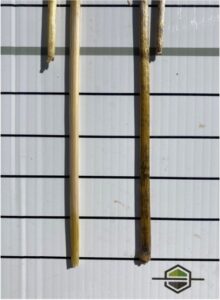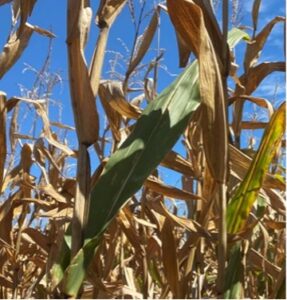At Advanced Agrilytics, we seek to understand the environment first and isolate the underlying mechanism that influences potential productivity. We’ve spent months walking side-by-side with growers. This time of year, we view yield as an outcome of the time and energy spent in proactively managing the crop during the growing season.
At this point in the 2022 harvest, we believe we have isolated at least one of the mechanisms influencing corn yield that may be contributing to the yield monitor dropping lower than desired. It appears that top dieback in corn — corn plants dying from the top down — has had some effect.
As some of the earlier planted corn began to dry down and we finished in-field evaluations, we noticed the corn crop finishing grain fill with plants maturing from top down as well as bottom up below the ear leaf. Soon after, as combines started to roll, it was apparent that what we saw was widespread across geographies and within fields. This seems to be the case in lower yielding environments hit hard with drought or those we would expect over 250 bushel/acre. Whenever we see something removing bushels, it is worth taking a closer look, and top dieback is something you can easily miss, especially if harvesting dry corn when all the green is gone out of the plant.
There can be many reasons plants die from the top down, including European corn borer and drought stress during pollination and grain fill. However, this top dieback appears to be affecting high-yielding areas with ample rainfall, as well as lower-yielding acres that have seen a dry August and September.
From our observations, anthracnose top dieback is the leading culprit. This can present itself in a couple of ways. If you are in high-yielding corn you may not notice top dieback. But in our experience, it may still be robbing yield. Picture 1 gives a good example of this. Top dieback in this case isn’t affecting entire areas. But, in almost every plant you can find evidence of It.
One way to distinguish drought stress top dieback from anthracnose top dieback is the presence of black lesions on the outer stalk tissue behind the leaf sheaths. In this example, plants were taken from next to each other in the same row. In both cases, the pathogen is likely present, but one plant shows no visible symptomology, while the plant with visible anthracnose lesions died prematurely in Picture 2. This is Important because we know we can gain as much as 1.7 bushel per day in kernel weight for every day the plant is alive. Avoiding premature death can increase final bushels quickly. These same two plants had similar ear kernel counts, but the plant that withstood the anthracnose top dieback and stayed alive longer had 10% more kernel weight. That may not sound like much, but at 225 bushel/acre corn, that’s a 22.5-bushel decrease in yield.
The other situation we find in 2022 is anthracnose top dieback in areas that have been dry. In these areas with sub-200 bushel/acre corn, the same anthracnose is apparent but came on much sooner and often impacted whole areas within fields. In these cases where we have multiple plants in a row with severe top dieback and subsequent early plant death, we are seeing as much as 100-bushel swings in yield from top to bottom.
At Advanced Agrilytics, we see many acres in different rainfall patterns, planting conditions, fertility programs, etcetera, giving us the ability to isolate and identify common denominators that may protect bushels going forward. The one thing we are consistently seeing is that stalk diameter really matters as seen in the Picture 3. These are the same two plants from the previous pictures and kernel weights. This is something we see consistently across our entire footprint. Plants that were able to accumulate more carbohydrate in the lower stalk or “build a bigger tank” were able to not only withstand drought in our drier areas, but also anthracnose top die
back as well.
Fungicides applied post tassel or even during vegetative stages are not effective against anthracnose top die back and hybrids are mostly tolerant according to literature, and yet we still have the issue. So let’s think about it proactively. If we visually see fewer issues from plant to plant, with thicker stalk plants having fewer issues and higher yields, how do we grow bigger stalks?
- Do you have enough phosphorous for every plant? Phosphorous increases stalk diameter.
- How about potassium? Potassium is vital to stalk strength. When we come across anthracnose top dieback in areas with below adequate potassium, we also anthracnose stalk rot and subsequent standability issues.
- How about your planter? We know that late-emerging plants are never the same size in height or stalk girth compared to the first plants to emerge. Late-emerging plants are likely going to succumb to anthracnose top dieback and perhaps other stalk related diseases, as well.
Ask your Advanced Agrilytics Precision Agronomist how to mitigate risks proactively in your next planning session.
Seth Logan
Precision Agronomist, Southern Illinois


